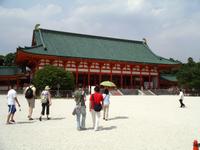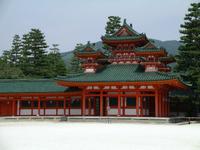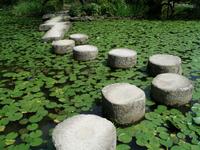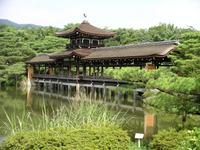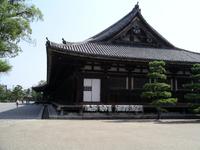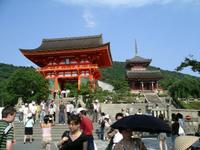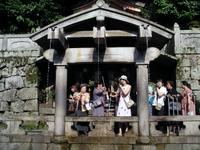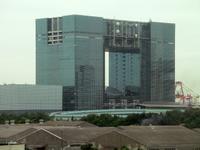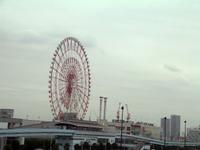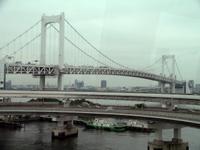Nara
Nara is a small town about 45 minutes from Kyoto. Not only was it the capital of Japan long long ago, but it was also the home of a powerful lord who was related to the Shogun. Because of this, it has a ton of temples and shrines, all within a huge park. Deer are sacred in the park, so they're allowed to run free. Tourists buy deer crackers to feed the deer - but watch out! The deer can sniff out those crackers and they'll mob any tourist who buys one. (We mostly saw parents forcing their children to feed the deer for photo ops - children who are now deeply traumatized by the experience and will forever fear anything with antlers.)


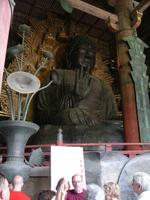 The main attraction in Nara park is the Big Buddha Hall. This wooden structure is the largest wooden structure in the world (or so their pamphlets claim.) The buddha inside is also huge and it's hard to get an idea of just how big from my picture. The lotus petals at his base are probably eight feet tall. The amazing thing is that the hall is even smaller than the original buddha hall which had to be replaced.
The main attraction in Nara park is the Big Buddha Hall. This wooden structure is the largest wooden structure in the world (or so their pamphlets claim.) The buddha inside is also huge and it's hard to get an idea of just how big from my picture. The lotus petals at his base are probably eight feet tall. The amazing thing is that the hall is even smaller than the original buddha hall which had to be replaced.
There were also several other shrines and temples in Nara park, including one that's famous for its many stone lanterns. By then we were a little templed-out, and we returned to Kyoto after a nice walk through the forested park (avoiding deer!)
Kyoto at Night
After our busy day of tours, we decided to relax and so we stopped at a beer garden on the roof of a hotel overlooking the Kamo River. We could see the crowds from the Gion festival and several people setting off small fireworks. The bluish thing in the right-hand picture is a cloth sculpture with some kind of fan and light under it to keep it blowing upwards. It's shaped like a man, but it's hard to tell from this angle. The light changed color frequently, so it was neat to look at.
 Later, we walked through Gion, tried some Takoyaki (fried octopus dumplings) and even chased down a geisha so we could get a picture. (They can really hustle in those tall wooden shoes!)
Later, we walked through Gion, tried some Takoyaki (fried octopus dumplings) and even chased down a geisha so we could get a picture. (They can really hustle in those tall wooden shoes!)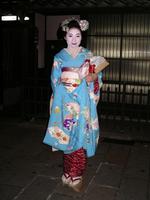
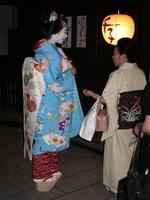
Kyoto Morning Tour
On Friday morning, we hopped on a tour bus for our JTB Sunrise Tours Kyoto Morning Tour. The buses left from our hotel, which was very convenient. Our tour guide for the morning was a stodgy old fellow with a wonderful accent. We were also signed up for buffet lunch and the Kyoto Afternoon Tour immediately following the Morning Tour.
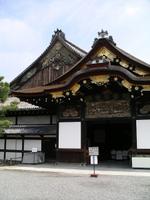 First stop for the morning was Nijo Castle. From the 17th to 19th centuries, Japan was ruled by a Shogun, or warlord. Although an emperor still existed, he was largely a figurehead since the Shogun controlled the military. The Shogun lived in Edo (now Tokyo) and the emperor lived in Kyoto. The Shogun would occasionally visit Kyoto to pay his respects to the emperor, though the gesture didn't mean much and not all of the men who were Shogun bothered to do it. While in Kyoto, the Shogun stayed at Nijo Castle. Although it's called a castle, it looked more like a stronghold to me - huge walls, quite a few buildings, but no tall donjon or keep. My two favorite features of Nijo Castle were the beautiful paintings on the interior walls (which we weren't allowed to photograph) and the nightengale floors. A nightengale floor is a floor designed to squeak loudly when someone walks across it. That way they can detect intruders quite easily. The castle's garden was also very nice and featured a pond with large stones and trees around it. Nijo Castle was my favorite part of the morning tour.
First stop for the morning was Nijo Castle. From the 17th to 19th centuries, Japan was ruled by a Shogun, or warlord. Although an emperor still existed, he was largely a figurehead since the Shogun controlled the military. The Shogun lived in Edo (now Tokyo) and the emperor lived in Kyoto. The Shogun would occasionally visit Kyoto to pay his respects to the emperor, though the gesture didn't mean much and not all of the men who were Shogun bothered to do it. While in Kyoto, the Shogun stayed at Nijo Castle. Although it's called a castle, it looked more like a stronghold to me - huge walls, quite a few buildings, but no tall donjon or keep. My two favorite features of Nijo Castle were the beautiful paintings on the interior walls (which we weren't allowed to photograph) and the nightengale floors. A nightengale floor is a floor designed to squeak loudly when someone walks across it. That way they can detect intruders quite easily. The castle's garden was also very nice and featured a pond with large stones and trees around it. Nijo Castle was my favorite part of the morning tour.

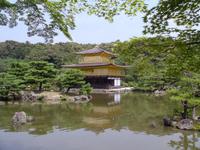 The second stop, which was a bit outside of town, was Kinkakuji, the Golden Pavilion. Kinkakuji is actually just one building on the grounds of Rokuonji, a zen buddhist temple. Rokuonji was originally the estate of a powerful relative of the Shogun, but he became a monk and turned his estate into a monastery. The golden pavilion was used as a tea house and although it was destroyed several times in the 14 and 1500's, it managed to survive unscathed until 1950, when it was burnt down by a young monk for reasons that will never be known. It was rebuilt five years later.
The second stop, which was a bit outside of town, was Kinkakuji, the Golden Pavilion. Kinkakuji is actually just one building on the grounds of Rokuonji, a zen buddhist temple. Rokuonji was originally the estate of a powerful relative of the Shogun, but he became a monk and turned his estate into a monastery. The golden pavilion was used as a tea house and although it was destroyed several times in the 14 and 1500's, it managed to survive unscathed until 1950, when it was burnt down by a young monk for reasons that will never be known. It was rebuilt five years later.
Our third stop was the Kyoto Imperial Villa, which is where the emperor used to live. It is now mostly used to store certain ceremonial objects such as the imperial throne used for the enthronement ceremony for a new emperor. Part of it is still closed off in case someone from the imperial household does decide to visit, so security is pretty tight. Each tour group has a security guard assigned to them to watch for anyone straying away from the group. The buildings were pretty, but we didn't get to see any of the interiors, so it wasn't as interesting as Nijo Castle. The Villa's garden was very similar to Nijo Castle's garden.
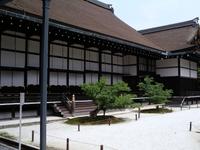
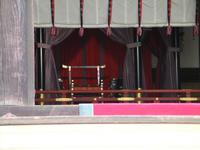
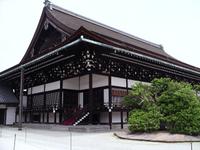
Gion Matsuri, Kyoto Summer Festival
Gion Matsuri is one of Kyoto's most famous festivals. It culminates in a parade of huge floats on the 17th of July. We enjoyed all of the festivities leading up to the parade, but weren't able to see the parade itself since we flew home on the 17th.
Gion Matsuri is several hundred years old. It originated as a way to appease the gods who were bringing famine and plague to Kyoto. The main parade on the 17th involves 32 Yama and Hoko floats. The Hoko floats are two stories and usually have a bunch of boys playing traditional instruments on the second story. Although they have wheels (as tall as me!), it still takes about 80 men to push and pull the Hoko floats around the parade and turning the floats is a major feat of engineering. Each float is sponsored by a particular neighborhood or merchant organization.
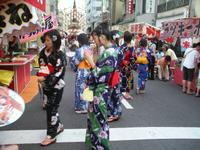 The three days leading up to the parade are called the yoi-yoi-yoi-yama, yoi-yoi-yama, and yoi-yama (which roughly translates to "the eve of the eve of the eve before the parade" and so on.) The streets of the central shopping area of Kyoto are closed to vehicles during this time and the whole area becomes a huge street festival. The total area was about five by ten blocks (big blocks). The side streets contained kids games, food stalls, drink stands, and souvenir merchants. The main focus of the "yoi-yama" is the display of the floats that will be paraded around on the 17th. Although we missed the parade, we still got to see quite a few of the floats just by walking around the street festival.
The three days leading up to the parade are called the yoi-yoi-yoi-yama, yoi-yoi-yama, and yoi-yama (which roughly translates to "the eve of the eve of the eve before the parade" and so on.) The streets of the central shopping area of Kyoto are closed to vehicles during this time and the whole area becomes a huge street festival. The total area was about five by ten blocks (big blocks). The side streets contained kids games, food stalls, drink stands, and souvenir merchants. The main focus of the "yoi-yama" is the display of the floats that will be paraded around on the 17th. Although we missed the parade, we still got to see quite a few of the floats just by walking around the street festival.
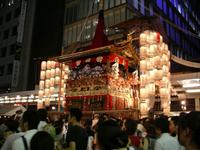 The huge hoko floats had 15th century Turkish and Dutch tapestries hanging off of them and lots of paper lanterns. Many of them had a tall pole or tree stuck on top such that they ended up looking like small towers.
The huge hoko floats had 15th century Turkish and Dutch tapestries hanging off of them and lots of paper lanterns. Many of them had a tall pole or tree stuck on top such that they ended up looking like small towers.
My favorite part of the festival was that about 1/3 of the young women (and a few men and children also) wore yukata, light cotton kimono worn in the summer. The yukata were very colorful and definitely added to the festive atmosphere.
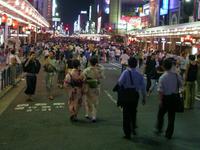 We greatly enjoyed seeing this traditional aspect of Japanese culture, but by the third day, the "yoi-yama", it was so crowded that we didn't stay too long. The police had to designate certain side streets as one-way (for foot traffic!) because it was so packed.
We greatly enjoyed seeing this traditional aspect of Japanese culture, but by the third day, the "yoi-yama", it was so crowded that we didn't stay too long. The police had to designate certain side streets as one-way (for foot traffic!) because it was so packed.
New Miyako Hotel
We returned to Kyoto and checked in to our hotel. It was right next to the train station and had a view of the tracks. Our room was nice and the hotel staff was very helpful, but it wasn't anything special.
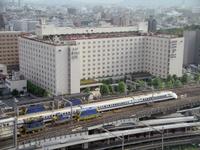
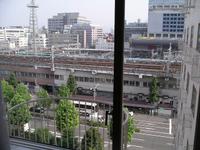
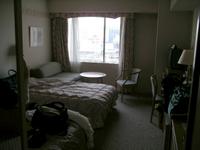
Fushimi Inari Shrine
 Upon arriving in Kyoto, it was too early to check into our hotel, so we dropped off our luggage and hopped on the JR Nara line. We got off at Inari Station and walked a block to the Fushimi Inari Shrine. It was painted red and had lanterns up all over. A ceremony of some kind was going on, so we walked quietly around the shrine grounds.
Upon arriving in Kyoto, it was too early to check into our hotel, so we dropped off our luggage and hopped on the JR Nara line. We got off at Inari Station and walked a block to the Fushimi Inari Shrine. It was painted red and had lanterns up all over. A ceremony of some kind was going on, so we walked quietly around the shrine grounds.
 Several trails lined with red torii gates led up the hill behind the shrine so we started up the hill. It was a very long walk and took several hours to get to the top of the hill and back down again. Along the way were several small tea houses with soda machines, a couple of small lakes, and more mini shrines and fox statues. It was very beautiful and with the ravens cawing, wind blowing through the trees, cats yowling in the distance, and other assorted birds and nature sounds, it felt very mystical too.
Several trails lined with red torii gates led up the hill behind the shrine so we started up the hill. It was a very long walk and took several hours to get to the top of the hill and back down again. Along the way were several small tea houses with soda machines, a couple of small lakes, and more mini shrines and fox statues. It was very beautiful and with the ravens cawing, wind blowing through the trees, cats yowling in the distance, and other assorted birds and nature sounds, it felt very mystical too.
Shinkansen (Bullet Train)
We rode the Hikari bullet train south from Tokyo. Our plan was to stop in Nagoya for the day and go to the Aichi Expo (world fair) just outside of Nagoya and then on to Kyoto in the evening. The ride was about two hours and relatively uneventful. I bought a bento at the Tokyo train station before we left. (A bento is a Japanese-style flat lunch box - kind of like a tv dinner but with fresh foods meant to be eaten cold).

 Five minutes before we arrived in Nagoya, Lisa suggested that we skip Nagoya and head straight on to Kyoto since there was so much to see and do there. I agreed, hopped up, and ran through about five train cars to find the conductor and explain in mixed English and Japanese that we wanted to stay on the train through to Kyoto and was that OK. They said yes, and I walked back to our seats, dodging people getting their luggage out for the Nagoya stop.
Five minutes before we arrived in Nagoya, Lisa suggested that we skip Nagoya and head straight on to Kyoto since there was so much to see and do there. I agreed, hopped up, and ran through about five train cars to find the conductor and explain in mixed English and Japanese that we wanted to stay on the train through to Kyoto and was that OK. They said yes, and I walked back to our seats, dodging people getting their luggage out for the Nagoya stop.
 It was another 45 minutes or so to Kyoto and we arrived in Kyoto before noon.
It was another 45 minutes or so to Kyoto and we arrived in Kyoto before noon.
Microsoft's Shinjuku Office
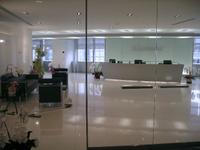 Since we spent four working days here, I figured a few folks would like to see what the Shinjuku office looks like. The office is in the same tall building as our hotel, though we needed to go down to the second floor and into a different elevator to get to the Microsoft offices on the 6-19th? floors. (The hotel is floors 20+, our rooms were on floor 29.)
Since we spent four working days here, I figured a few folks would like to see what the Shinjuku office looks like. The office is in the same tall building as our hotel, though we needed to go down to the second floor and into a different elevator to get to the Microsoft offices on the 6-19th? floors. (The hotel is floors 20+, our rooms were on floor 29.)
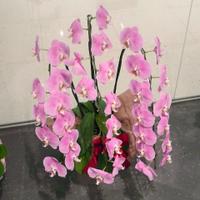 You might notice the orchids and other flower arrangements in the lobby picture above. The orchids are a traditional gift from one family or corporation to another. In this case, they're for the newly appointed head of our Msft Japan group. We saw some for sale at a store - they're $250!
You might notice the orchids and other flower arrangements in the lobby picture above. The orchids are a traditional gift from one family or corporation to another. In this case, they're for the newly appointed head of our Msft Japan group. We saw some for sale at a store - they're $250!
Instead of offices, each employee has a cubicle, which aren't very large or private. Also, every last of inch of space gets used for storage.


Each floor, aside from the receptionist floor (which is all fancy conference rooms), seems to have a guest area (the wide white tables - which is where we worked), an informal conference area (the room with partitions), drink machines (the coffee drinks on the left are free, the rest are about half subsidized), and a confusing array of trash bins.
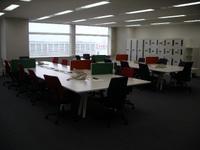
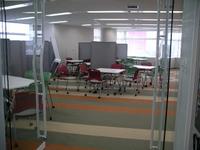
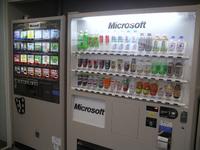
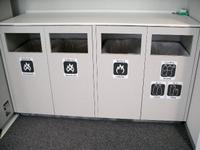


 The main attraction in Nara park is the Big Buddha Hall. This wooden structure is the largest wooden structure in the world (or so their pamphlets claim.) The buddha inside is also huge and it's hard to get an idea of just how big from my picture. The lotus petals at his base are probably eight feet tall. The amazing thing is that the hall is even smaller than the original buddha hall which had to be replaced.
The main attraction in Nara park is the Big Buddha Hall. This wooden structure is the largest wooden structure in the world (or so their pamphlets claim.) The buddha inside is also huge and it's hard to get an idea of just how big from my picture. The lotus petals at his base are probably eight feet tall. The amazing thing is that the hall is even smaller than the original buddha hall which had to be replaced.




